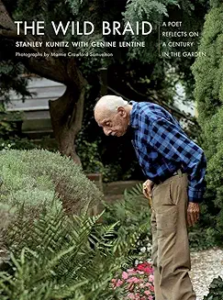The Wild Braid: A Poet Reflects on a Century in the Garden by Stanley Kunitz 2005
I read this book in 2012 and again in 2021. Reading it for the third time, I still found it profoundly moving.
Kunitz who died just short of his 101st birthday a year after this book was published is one of America’s great poets—the Pulitzer Prize, the National Book Award, the Bollingen Prize, the Robert Frost Medal, and twice the U.S. Poet Laureate–a truly distinguished lifetime of creativity.
He led a fascinating and turbulent life. Born to Lithuanian Jews in Worcester, MA, his father committed suicide before he was born and was erased from Kunitz’s life by his mother. Graduating summa cum laude from Harvard and getting is MA there as well, he was denied a teaching position because he was Jewish. He wrote for newspapers and later taught at numerous colleges including Harvard, Columbia, Princeton, Vassar, and Bennington. Twice divorced, he married Elise Asher, an artist, and their marriage lasted 48 years. Through Asher he met Mark Rothko, Franz Kline and other artists and was a founder of the arts center in Provincetown, MA.
It was there that he bought a falling down house on a dune on Commerical Street in 1962 and began his garden. Terracing the hill and improving the soil with seaweed and compost, he spent his summers in Provincetown writing poems in the evening and working all day in the garden.
This book is a testament to both activities, filled with his thoughts on the art of poetry and the parallel art of gardening. Both depend on patterns, repitition, suprise, and the ‘ahah’ monent of discovery, I closely identified with several of his comments from his love for the Dawn Redwood (“the antiquity of a tree is a concentration of cosmic energy”)and Japanese anemones to his statement that “I am never absent from the garden, an abiding companion during the whole year. It’s what I think of first when I think of leaving and think of returning.” Me, too. Here’s Kunitz comparing poetry to gardening: “As with the making of a poem, so much of the effort is to get rid of all of the excess, and at the same time be certain that you are not ridding the poem of its essence”. I can certainly agree with that statement since I spend 90% of my time in the garden pruning, cutting back, pulling out, and/or transplanting the result of 38 years of gardening here in Vermont!
However, as much as I loved his musings on gardening and poetry, the highlight of the book is its collection of 12 poems. Four of them are featured in this month’s Poetry Tree on the Charles and are among my favorite poems: “The Layers”, “Touch Me”, “The Long Boat”, and “The Round”. Each one has a deep and meaningful message about life, time, friends, aging, death. “The Layers” ends with these lines: “Live in the layers,/not on the litter./Though I lack the art/to decipher it,/no doubt the next chapter/in my book of transformations/is already written./I am not done with my changes.” And here’s how “Touch Me” ends: So let the battered old willow/thrash against the windowpanes/and the house timbers creak./Darling, do you remember /the man you married? Touch me,/remind me who I am.” Here are the final lines from “The Long Boat”: “Peace! Peace!/To be rocked by the Infinite!/As if it didn’t matter/which way was home;/as if he didn’t know/he loved the earth so much/he wanted to stay forever.” And finally, here’s how “The Round” ends: “I can scarcely wait till tomorrow/when a new life begins for me,/as it does each day,/as it does each day.”
What can I say after that?



